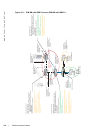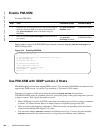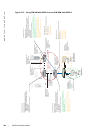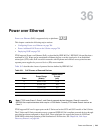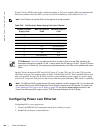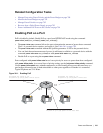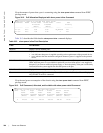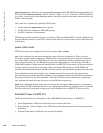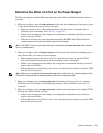
786 | Power over Ethernet
www.dell.com | support.dell.com
For the C-Series, FTOS requires that a minimum number of AC power supplies (PSU) be installed before
PoE can be enabled, and some PSUs are reserved for PoE redundancy, as described in Table 36-2.
On the C-Series, though each PSU used for PoE (units 4-7 on the C300, and 3-4 on the C150) provides
1200 Watts of power, each actually makes available 1478.40 Watts for PoE. This is possible because each
unit, once installed, borrows 278.40 Watts from the system redundancy power supply. If a power supply
used for PoE is removed, PoE ports are shut down so that the system redundancy PSU retains is capability.
Configuring Power over Ethernet
Configuring PoE is a two-step process:
1. Connect the IEEE 802.3af-compliant powered device directly to a port.
2. Enable PoE on the port, as described next.
Note: The C-Series can provide PoE only through its AC power supplies.
Table 36-2. PoE Ports per Power Supply Unit in the C-Series*
Number of Power
Supply Units
Max PoE Ports on
C300
Max PoE Ports on
C150
1——
2 — System Redundancy
3 System Redundancy 96
4 96 192
5 192 PoE Redundancy
6 288 PoE Redundancy
7 384 N/A
8 PoE redundancy N/A
FTOS Behavior: Table 36-2 provides the maximum number of PoE ports per PSU, based on the
assumption that each port deliver 15.4W. In many cases, the PD requires <15.4W. Typical IP Phones
require only 3-10 Watts. So, if the ports are configured optimally, more PDs can be powered with fewer
PSUs.
Note: The S25V and S50V models contain AC power supplies in order to support PoE. You can also add
the external Dell Force10 470W Redundant Power Supply to power more PoE devices. For details, see
Power Additional PoE Ports on the S-Series on page 794 and see the power budget command in the
Power Over Ethernet (PoE) chapter of the FTOS Command Reference for the S-Series.



